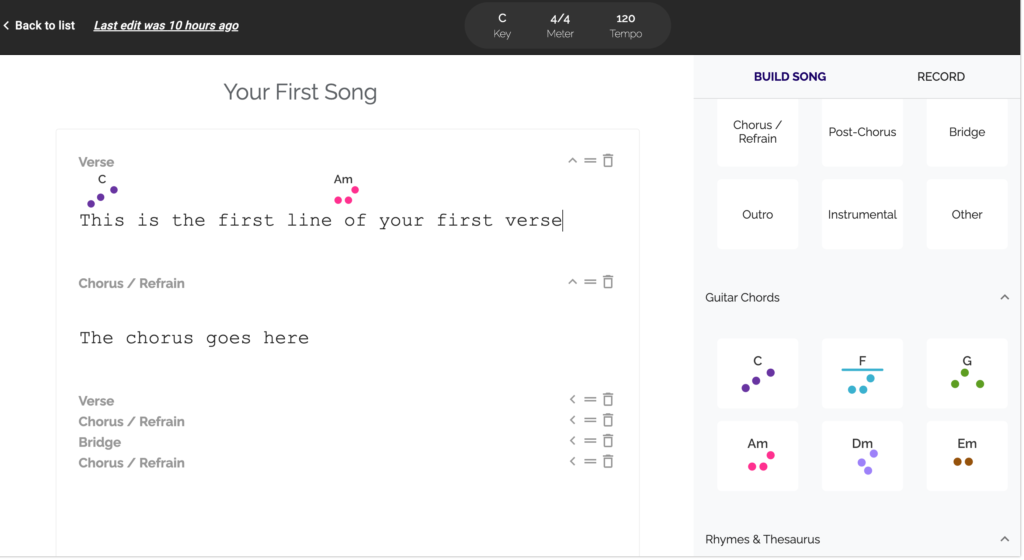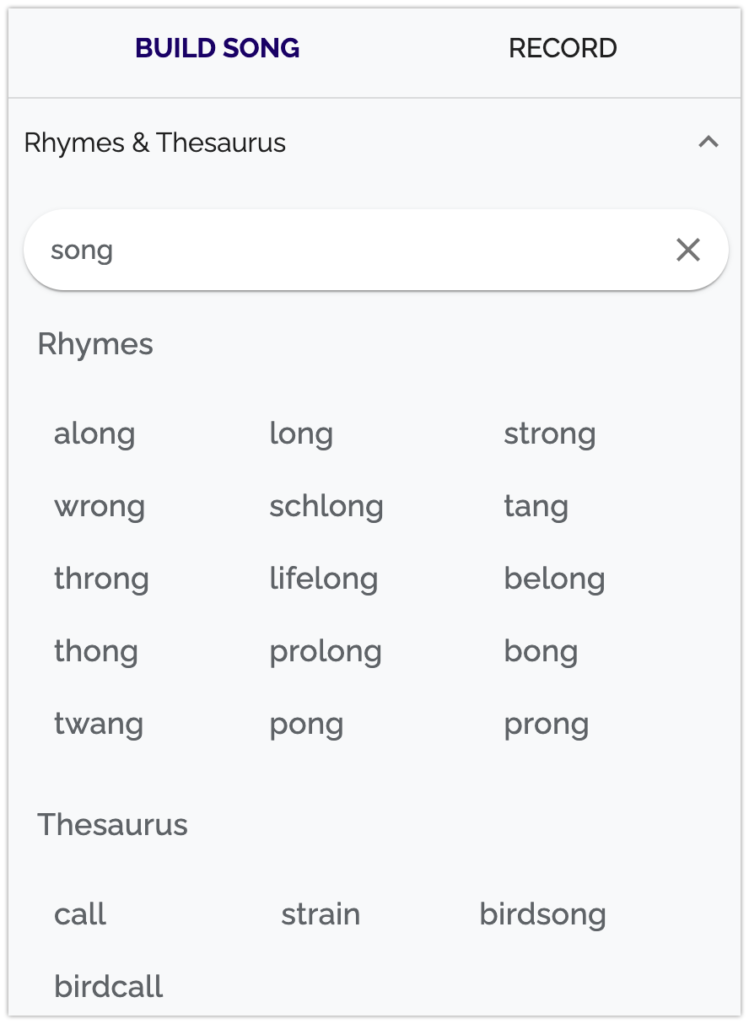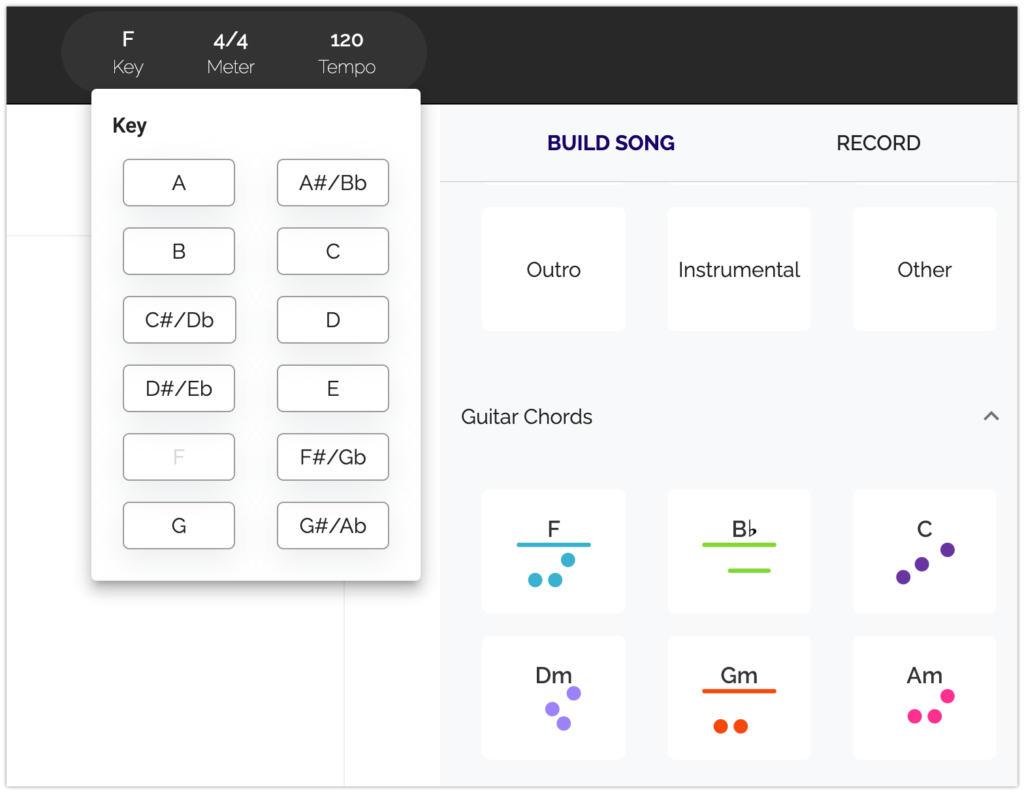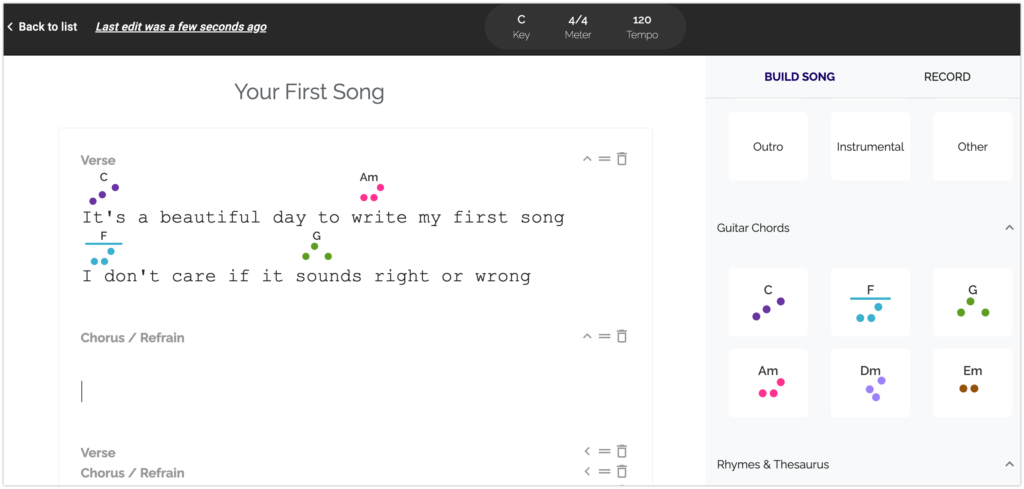If you’ve ever wondered how to write a song but didn’t know where to start, this article is for you. We’ll cover song form, lyrics, and musical song structure that will act as training wheels for your first song. Just follow along and fill in the pieces.
A key feature of Moosiko is our beginner songwriting tool that allows you to easily build song structures, write lyrics, drop chords. Moosiko even has built-in rhyme dictionary and recording. Signup free here.

Moosiko Songwriting tool makes it easy to construct your first song
Basic Parts of a Song
Good songs tell good stories. And just like stories, songs are broken up into different parts to pull the listener though the story. The three main parts of a song are Verse, Chorus, and Bridge. If you’re using Moosiko, you can add, remove, reorder, and name these song structures as you build your song.
- Verse: Songs typically have 3 – 5 verses and tell the “story” of the song. Usually the same melody is used in every verse.
- Chorus: The most memorable part of the song that repeats lyrics and melody. The chorus is typically the “climax” or “main point” of the story. The chorus can be called the “refrain” or the “hook”.
- Bridge: Occurs ~75% of the way through a song and is different in lyrics and melody. The bridge breaks up the repetitive nature of songs and can act as a turning point in the story.
The verse, chorus, and bridge make up 90% of most songs. Songs can have other structures like intros, pre-choruses, post-chorus, etc. But these three basic elements will be sufficient for your first song.
The song form is how the structures are arranged. There are many kinds of song forms but the one we’ll use for your first song is as follows:
- Verse
- Chorus
- Verse
- Chorus
- Bridge
- Chorus
The first thing to do in Moosiko is to build your song structure as a guide.

Collapsed view of all the song structures
The Lyrics
What are you going to write about now!?! There are endless resources for writing lyrics that include journaling, literary devices, points of view, rhyming, and even crowdsourcing like Hookist. Remember that good songs are often good stories, even if it’s not your story. John Mayer’s Walt Grace Submarine Test is a perfect example.
We’re not going to dive into detail about lyric writing but a common starting point are song prompts. Prompts are thought provoking questions or statements that get you started. Pick a prompt below and see if you jot down some thoughts
- Write a song about your favorite city, vacation, or place to visit
- Pick and object you can see right now and write a song about that
- Pick your favorite subject and write a song about the key fact you learned
- Write a song where every line starts with the same letter
- Without mentioning it, write a song from the perspective of an animal
- Write an anthem about something you are passionate about
- Hum or play a melody and write lyrics over that
Moosiko has built-in rhyme lookup and thesaurus to help write some fun lyrics.

The Melody
This is where things get musical. Melodies are the notes that make up how the song sounds. It is the melodies + lyrics that makes a song catchy and why it gets stuck in our heads. It is hard to teach melody in a blog so the best thing to do is go listen to a few songs and hear how the melody changes between verse and chorus and with various songs or genres.
Keep your melodies simple. Usually the simple melodies make the best songs! Here are a few examples that you should be able to easily hum to:
- Lean on Me by Bill Withers (the first verse is 3 notes up and 3 notes down)
- Sometimes in our lives, We all have pain
- Shake it Off by Taylor Swift (chorus repeats the same descending line of notes and words)
- Players gonna play, play, play, play, play
- Mr. Brightside by The Killers (verse is just one note)
- Coming out of my cage and I’ve been doing just fine
If you really want to make things easy, just copy the melody of a song you like and write new lyrics to it (this is great for learning purposes, don’t copy songs for commercial purposes). Once you get some lyrics down, start experimenting by changing the melody.
The Harmony
Harmonies are usually played by guitar or piano instruments to create a series of chord progressions. Chord progressions make up the foundation of how the music flows.They pair with the melody to make the song, and well…a song. If you play guitar or piano, great! If not, find someone who does to help with this part.
The good news is that many chord progressions are the same! Many songs use the same chords and chord progressions, especially in pop songs. Here are some examples
- Let it Be by the Beatles: a relatively simple 4 chord progression on piano is heard in the first 12 seconds
- Wagon Wheel by Old Crow Medicine Show: the first four guitar chords are clear as day before the fiddle kicks in
- Watermelon Sugar by Harry Styles: listen to the four chords played on the electric guitar in the background
You can get a degree in music theory, which we’re not going to get into here. Moosiko makes it easy to find chords that sound good together. Select a key and the chords will display that are part of that chord family. Here are some common major keys (it’s ok if you don’t know what that means) to pick some chords and just start playing.

Select a key to see the chord family that sounds good together
Pick 4 chords and play them to see how they sound. If not great, rearrange them. Keep experimenting until you get something you like. Drag and drop them over your lyrics to start to build your song.

When you find a chord progression you like, drag and drop over your lyrics
Note that in hip hop and rap genres more emphasis is placed on beats and less on harmonies.
Your First Song
There is no correct order to write a song. Many artists write music and put lyrics to that (many examples on YouTube). Some write lyrics and then wrap music around it (watch Rocketman to see Elton John do it this way). You can write the chorus first or the verse first. Do whatever is comfortable for you. A few final tips:
- Songs don’t have to be long. Even 2 lines for a verse or chorus is perfectly fine
- Finish the song. It’s your first one and you’ll feel good about completing it, even if its not perfect
- It won’t be perfect and will probably stink…that is ok. The best songwriters in the world need to write hundreds of songs for one good one
Hopefully this guide gives you the building blocks to write and play your first song.
